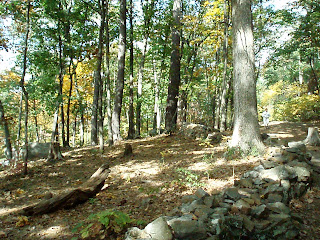At my dad's Military school in Washington D.C. they had a family trip to Gettysburg.
My dad and I and a whole bus full of students and family took the trip.
We had two teachers from the school giving the tour. These teachers had their doctorates in Gettysburg history so the facts they presented to us were well studied.


Colonel Chamberlain and the 20th Maine on Little Round Top.

The Confederate leaders at Gettysburg. Men who are sitting: Left- Picket, Middle- Lee,
Standing Right side two over- Longstreet, Standing middle left- Armistead friends with General Handcock. Red uniform- British Embassador to the Confederates. ohe British were thinking of coming in on their side because of the economic benefits of the agricultural south.

On the first day of the battle of Gettysburg a small group of Union Cavalry held the ground
outside Gettysburg near the Luthern Seminary against the Confederates. The dismounted cavalary held until the Union brought up the supporting infantry.

Durning the battle of Gettysburg their were war dogs similar to the ones on Guam in World War II. The one story the teachers told were of a small dog that was a mascot of a battalion of Union soldiers. The little dog would march along with the soldiers. When she was killed in battle the soldiers stopped their attack and buried her before continuing the attack.

Being at Gettysburg was a sacred experience knowing how many had died there.
The hill I am pointing at is Little Round Top. This hill was the site of the historic hold by the 20th Maine against overwhelming Confederates. When the 20th Maine was low on ammunion they fixed bayonets and with the down hill chasing the Confederates off. The 20th Main's Commander Colonel Chamberlain earned the Medal of Honor for orchestrating the hold and the charge on Little Round Top.

Here is the place where the 20th Maine held their ground against overwhelming odds.


This red farm house was a Hospital for wounded soldiers in the movie "Gettysburg". The country side is beautiful. It is hard to imagine all the blood and gore that occered on such beautiful ground.

On one side of the field of Picket's Charge is a statue of General Robert E. Lee. There is a Union general facing him on the Union side of the field, almost a mile away.

The field of Picket's Charge

The place where the Union soldiers held the Confederates attack back.

The place where the Confederate charge stopped.
On the third day of the Battle of Gettysburg the Confederates under command of Roberet E. Lee made a daring charge across an open field, a mile long. The confederates had Colonel Alexander's artillary, but the foot solders who had to march across the field were still desimated because they were fully exposed to the Union guns. General Picket never forgave Lee for ordering the charge that killed almost all his men.
On the Union side, General Hancock and his men under the barrage of the Alexander's artillary quickly set up defenses against the inevitable infantry attack. Their defences worked and they succeded in holding their line just as the Confederates had at Fredersburg. So desimated was the Confederates that General Mead, General Handcock's superior refused to chase the Confederates after they retreated because it would have been a slaughter. General Mead received chastisement from President Lincoln for letting the Confederates go. General Mead gave the honorable order by not completely slaughtering the helpless Confederates.

Later, General/President Eisenhower bought a piece of property here in Gettysburg. He wanted to have a Gettysburg address like the Lincoln, Gettysburg Address.
















